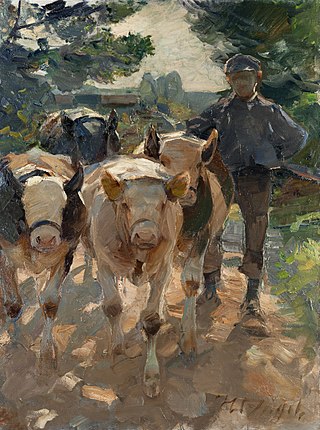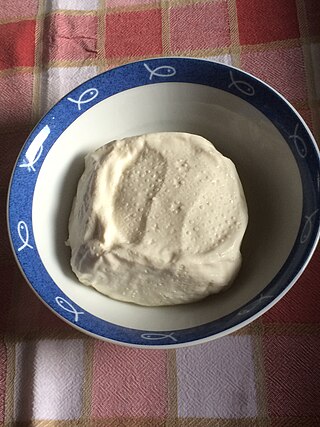
Dorset Blue Vinney is a traditional blue cheese made near Sturminster Newton in Dorset, England, from cows' milk. It is a hard, crumbly cheese. It was formerly made of skimmed milk.

Gorgonzola is a veined protected designation of origin (PDO) Italian blue cheese, made from unskimmed cow's milk. It can be buttery or firm, crumbly and quite salty, with a "bite" from its blue veining. Outside the EU and the countries recognizing the geographical origin protection, the name "Gorgonzola" can legally be used for similar cheeses, with only the full Italian name unambiguously referring to PDO Gorgonzola. It is a famously pungent cheese.

Goat cheese, goat's cheese or chèvre is cheese made from goat's milk. Goats were among the first animals to be domesticated for producing food. Goat cheese is made around the world with a variety of recipes, giving many different styles of cheeses, from fresh and soft to aged and hard.

Kashkaval is a type of cheese made from cow's milk, sheep's milk or both. In Albania, Bulgaria, Kosovo, North Macedonia, Romania and Serbia, the term is often used to refer to all yellow cheeses. In English-language menus in Bulgaria, kashkaval is translated as "yellow cheese".

Asiago is a cow's milk cheese, first produced in Asiago in Italy, that can assume different textures according to its aging, from smooth for the fresh Asiago to a crumbly texture for the aged cheese. The aged cheese is often grated in salads, soups, pastas, and sauces while the fresh Asiago is sliced to prepare panini or sandwiches; it can also be melted on a variety of dishes and cantaloupe. It is classified as a Swiss-type or Alpine cheese.

Ricotta is an Italian whey cheese made from sheep, cow, goat, or Italian water buffalo milk whey left over from the production of other cheeses. Like other whey cheeses, it is made by coagulating the proteins that remain after the casein has been used to make cheese, notably albumin and globulin.

Kasseri is a medium-hard or hard pale yellow cheese made from pasteurised or unpasteurised sheep milk and at most 20% goat's milk. "Kasseri" is a protected designation of origin, according to which the cheese must be made in the Greek provinces of Thessaly, Macedonia, Lesbos, or Xanthi, but a similar type of cheese is found in Turkey, Romania, and the Balkans, where it is known as kashkaval. The same cheese is made with cow's milk, but in that case it cannot be legally sold as "kasseri" in the EU and is instead sold under names that are particular to each producer.

Toma is a soft or semi-hard Italian cow's milk cheese, noted for its excellent melting qualities. It is made primarily in the Aosta Valley and Piedmont regions of Northwestern Italy. Toma varies with region and locale of production, and is closely related to the French tomme.

Grana Padano is a cheese originating in the Po Valley, in Northern Italy, that is similar to Parmigiano Reggiano. There are less strict regulations governing its production compared to Parmigiano Reggiano. This hard, crumbly-textured cheese is made with unpasteurized cows' milk that is semi-skimmed through a natural creaming process. To preserve the authenticity of the manufacturing processes and raw materials used to make this cheese, Grana Padano is registered as Geographical Indication in Italy since 1954 and as a European Union protected designation of origin (PDO) since 1996, and is protected in several other countries based on the Lisbon Agreement and bilateral agreements.

Pecorino sardo is a firm cheese from the Italian island of Sardinia, made from sheep's milk, specifically from the milk of the local Sardinian breed. It was awarded denominazione d'origine status in 1991 and granted protected designation of origin protection in 1996, the year in which this European Union certification scheme was introduced.
White cheese includes a wide variety of cheese types discovered in different regions, sharing the sole common characteristic of their white hue. The specific type of white cheese can vary significantly depending on the geographical location.
Grana is a type of hard, mature cheese from Italy with a granular texture, often used for grating. Grana cheeses are typically made in the form of large wheels. The structure is often described as crystalline, and the wheels are divided by being split with a fairly blunt almond-shaped knife designed for the purpose, rather than being sliced, cut or sawn. Within the European Union the term "grana" is legally protected by Grana Padano protected designation of origin; only Grana Padano may be sold using the term in EU countries.

Hirtenkäse, or "herder's cheese", is a distinctive cow's milk cheese made in the Allgäu area of Southern Germany.

Cheeses in Mexico have a history that begins with the Spanish conquest, as dairy products were unknown in pre-Columbian Mesoamerica. The Spanish brought dairy animals, such as cattle, sheep, and goats, as well as cheesemaking techniques. Over the colonial period, cheesemaking was modified to suit the mixed European and indigenous tastes of the inhabitants of New Spain, varying by region. This blending and variations have given rise to a number of varieties of Mexican cheeses. These are most popular in the country, although European cheeses are made, as well. Almost all cheese in Mexico is made with cows’ milk, with some made from goats’ milk. More recently, efforts have been made to promote sheep's milk cheeses. Most cheeses are made with raw (unpasteurized) milk. Cheeses are made in the home, on small farms or ranches, and by major dairy product firms. Between 20 and 40 different varieties of cheese are made in Mexico, depending on how one classifies them. Some, such as Oaxaca and panela, are made all over Mexico, but many are regional cheeses known only in certain sections on the country. Some of the least common are in danger of extinction.

Cornish Yarg is a semi-hard cow's milk cheese made in Cornwall, England. Before being left to mature, the cheese is wrapped in nettle leaves to form an edible, though mouldy, rind. The texture varies from creamy and soft immediately under the nettle coating to a Caerphilly cheese-like crumbly texture in the middle.

Squacquerone is an Italian cheese soft and crumbly type, originally from Romagna.













